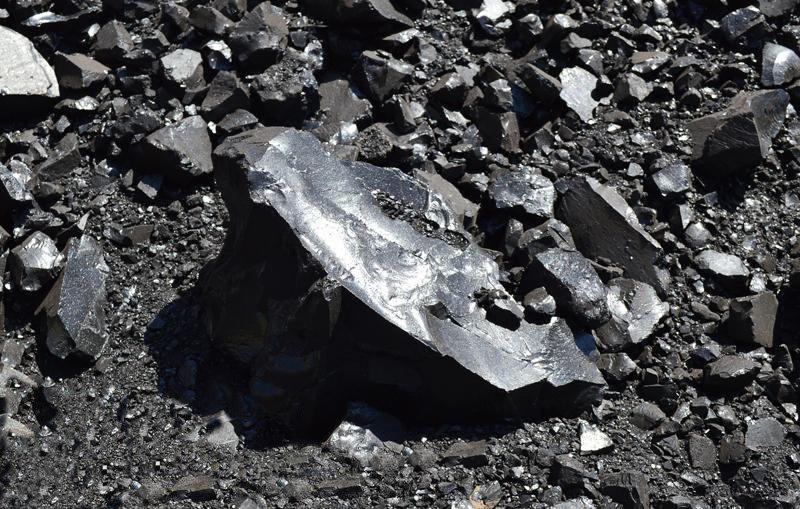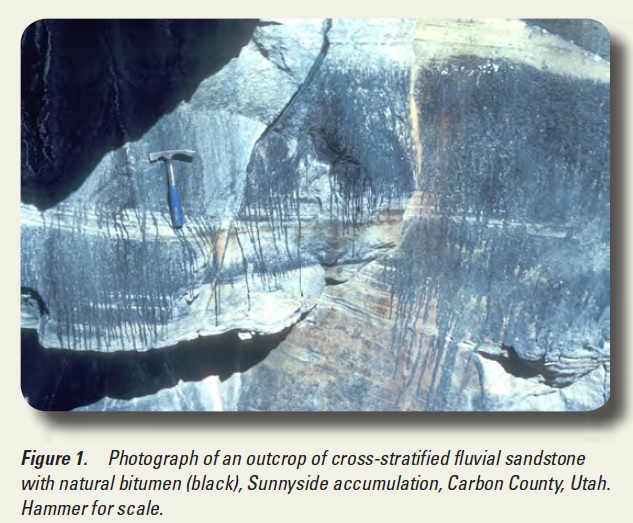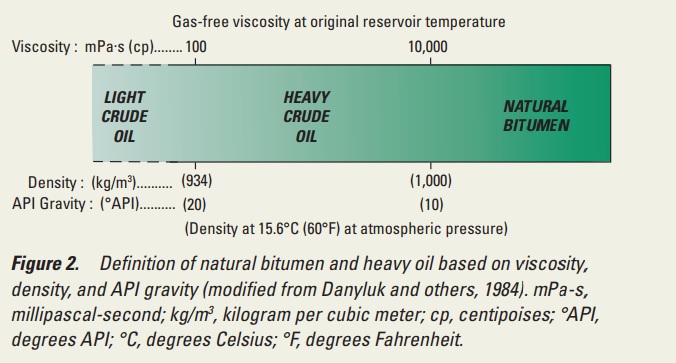Natural bitumen

Description of Natural Bitumen
RAHA GILSONITE is one of the best suppliers of natural bitumen in Iran. Natural bitumen is a natural resinous hydrocarbon found in mines in the different city of Iran. Contrary to what most people believe Natural Bitumen is the same as the Gilsonite mineral, in fact, there are many different names for Natural Bitumen used all over the world. Natural Bitumen is a must have addition for Ink, Foundry, Asphalt, Paint & Stains, Construction and Oil & Gas industries. Natural Bitumen is a unique mineral that is used in more than 160 products till now and we are always looking to expand. Natural Bitumen in mass is a shiny, black substance; it is brittle and can be easily crushed into a dark brown powder.
Natural bitumen and extra-heavy oil are characterized by high viscosity, high density (low API gravity), and high concentrations of nitrogen, oxygen, sulphur, and heavy metals. These characteristics lead to higher prices for extraction, transportation, and processing than are incurred with conventional oil. Despite their price and technical challenges, major international oil companies have found it desirable to acquire, develop, and produce these resources in increasing volumes. large in-place resource volumes provide a reliable long-term flow of liquid hydrocarbons and supply substantial payoff for any incremental improvements in recovery. High oil costs during 2007 and 2008 spurred new development and production that, in turn, have intensified concern concerning environmental effects of production increases.
Natural bitumen and extra-heavy oil are the remnants of terribly large volumes of conventional oils that are generated and degraded, principally by bacterial action. chemically and texturally, bitumen and extra-heavy oil resemble the residuum generated by refinery distillation of light oil. The resource base of natural bitumen and extra-heavy oil is immense and not a constraint on the expansion of production. These resources will create an important contribution to future oil offer if they’ll be extracted and transformed into usable refinery feedstock at sufficiently high rates and at prices that are competitive with alternative sources.
Natural bitumen
The definition of heavy oil has been terribly loosely based on the API gravity or viscosity. Such a definition of heavy oil is quite arbitrary and too general to be technologically accurate. There are attempts to rationalize the definition based upon viscosity, API gravity, and density, however, they also suffer from a lack of technical accuracy. most important, the flow properties of the heavy oil are reduced relative to conventional crude oil and heavy oil is much more difficult to recover from the subsurface reservoir. These materials have a high viscosity (and low API gravity) relative to the viscosity (and API gravity) of conventional petroleum and recovery of heavy oil usually needs the thermal stimulation of the reservoir.
Simply, bitumen is substantially non-volatile and immobile at reservoir temperatures. In fact, petroleum, and therefore the equivalent term crude oil cover a vast assortment of materials consisting of gaseous and liquid hydrocarbon-type chemical compounds that occur in sedimentary strata throughout the world. once petroleum occurs in a reservoir that permits the crude material to be recovered by pumping operations, as a free-flowing dark-to-light-colored liquid, it’s often referred to as conventional oil. heavy oil and bitumen require more energy-dependent ways of recovery from the heavy oil reservoir or from the bitumen deposit.
Natural bitumen
In addition to conventional petroleum, there are 2 other materials that offer some relief to the potential shortfalls within the supply of liquid fuels and other products.
These heavy oils, found in various reservoirs, and bitumen, found in tar-sand deposits. Tar sand (also referred to as oil sand and bituminous sand) could be a sand deposit that’s impregnated with dense, viscous material that’s usually immobile under reservoir conditions. Tar sand deposits are found throughout the world, often within the same geographical areas as petroleum, including and heavy oil.
The heavy oil in various reservoirs and also the bitumen in various tar-sand deposits represent a potentially large provider of energy. However, many of the reserves are available only with some difficulty and optional refinery scenarios are necessary for conversion of those materials to liquid products, because of the substantial differences in character between conventional petroleum and heavy oil when compared to tar-sand bitumen. However, because of the diversity of available info and the continuing attempts to delineate the various world tar-sand deposits, it’s virtually impossible to present accurate numbers that reflect the extent of the reserves in terms of the barrel unit. Indeed, investigations into the extent of many of the world’s deposits are continuing at such a rate that the numbers vary from one year to the next. accordingly, the info quoted here should be recognized as approximate, with the potential of being quite different from one year to the next. the general lack of a cohesive definition for heavy oil and for bitumen has prevented accurate estimation of those reserves. What can be classed heavy oil or bitumen in one locale can be classed otherwise in another locale. it’s apparent that bitumen is different to conventional petroleum and heavy oil.
Natural Bitumen Resources of the United States
Major natural bitumen accumulations in the United States are estimated to contain about 36 billion barrels of measured in-place resource and about 18 billion barrels of speculative in-place resource. Major natural bitumen resources are in Alabama, Alaska, California, Kentucky, New Mexico, Oklahoma, Texas, Utah, and Wyoming.
Introduction
Natural bitumen accumulations in the United States are generally known as “tar sands,” a generic term that has been used for several decades to describe petroleum-bearing rocks exposed on the Earth’s surface (fig. 1). Other terms for such accumulations include oil sand, oil-impregnated sand, asphaltic sand, rock asphalt, bituminous rock, and bitumen bearing rock. Natural bitumen is defined as petroleum with a gas-free viscosity greater than 10,000 centipoises (cp) at original reservoir temperature (fig. 2). Petroleum with a gas-free viscosity between 10,000 and 100 cp is generally termed heavy crude oil. In the absence of viscosity data, oil with API gravity less than 10 degrees is generally considered a natural bitumen (Danyluk and others, 1984), whereas oil with API gravity ranging from 10 degrees API to about 20 degrees API is considered heavy crude oil. The term “extra-heavy crude oil” is used for oil with a viscosity less than 10,000 cp but with API gravity less than 10 degrees. The locations of more than 500 accumulations of natural bitumen in the United States were compiled by Ball Associates Ltd (1965), but resource estimates were provided for only a limited number of the accumulations.

The most recent study providing The most recent study providing estimates of both measured and speculative in-place resources for the Nation’s major natural bitumen accumulations (those containing more than 100 million barrels of oil [MMBO] in-place) was by Lewin and Associates, Inc (1984). The estimates given in table 1 are from Lewin and Associates, Inc. (1984) for the conterminous United States and from Kamath and others (1995) for northern Alaska. These estimates represent in-place resources but do not represent either technically recoverable resources or economically recoverable resources. Recovery factors to determine technically or economically recoverable resources are difficult to predict, given that recovery procedures might range from surface mining to sub surface technology such as that involving steam-assisted gravity drainage from paired well bores. Measured resources are generally those estimated from areal dimensions and bitumen saturations of deposits at the surface. Speculative resources, on the other hand, are\ generally those representing the subsurface extension of a surface accumulation, so considerable uncertainty exists in estimating their volumes. For example, estimates of the speculative in-place bitumen resource for the Tar Sand Triangle accumulation in Wayne and Garfield Counties, Utah, range from 420 million barrels of bitumen (Lewin and Associates, Inc., 1984) to 16 billion barrels of bitumen (Campbell and Ritzma, 1979).

Iran Natural bitumen
In the recent years, Iran has become a major exporter of Natura Bitumen to India, China and many other countries in the region. Iran possesses some of the richest mines of Natural Bitumen, which are used in many industries, including road construction, the paint industry, polish and insulation of tanks and tubes and molding. Natural Bitumen or Gilsonite is also known as Natural Asphalt, Asphalting, and is soluble in petroleum asphalt solvents. Natural Bitumen is used in the hardening of oil products and it is easily converted to powder form. Natural Bitumen, Natural Asphalt, Gilsonite, Hard Asphalt or Hard Asphaltum is used as a performance-enhancing agent for asphalt mixes. Gilsonite-modified paving mixes achieve higher PG grades and incorporate perfectly into the asphalt blend with no need for high shear milling as is the case with many other modifiers. Natural Bitumen can partially or totally replace, or complement, the use of SBS polymers in modified asphalts at a fraction of the cost. Gilsonite-modified asphalts have higher stability, reduced deformation, reduced temperature susceptibility and increased resistance to water stripping than non-modified asphalts.
Iran Natural Bitumen in Paint, Ink, Coat, Asphalt, Foundry, and Construction
Natural Bitumen is also used to make both solvent-based and emulsion pavement sealers with superior appearance and weathering properties. Iranian Gilsonite is the other brand for the mineral known as natural bitumen which is found in Kermanshah and Gilane Gharb located in Iran and also found in Utah in the United States, but can be obtained from Iran at a fraction of the price than that of the U.S.Gilsonite primarily is used in dark-colored printing inks and paints, oil well drilling mud and cements, asphalt modifiers, foundry sands additives and a wide range of chemical products.
Natural bitumen have long been used in the paving of roadways, including high-speed automotive highways. It was found many years ago that an asphaltic material occurring naturally as a large area in Iran made up of bitumen containing natural asphalt products including hydrocarbons.
Natural bitumen in FLC (fluid loss control)
Natural bitumen use in drilling fluid such as clay-based dispersions or muds, to coat the walls of well holes, is an old and well-established procedure. The purpose of the fluid is to stabilize the walls of the hole by forming a relatively thin but strongly adherent coating or “cake” on the walls. The coating must be able to withstand relatively high temperatures and it should be resistant to the passage of moisture or fluid there through; otherwise, the desired wall stability is not maintained.
Natural bitumen in Ink
Natural bitumen is widely used as the primary carbon black wetting agent for black news inks and headset and toner inks. RAHA natural bitumen resin competes advantageously with hydrocarbon resins, phenolic resins.
Natural bitumen in Asphalt
We discovered that a synthetic flux oil can contain and deliver asphaltites, such as natural bitumen, more easily and readily to an asphalt to improve its properties. The synthetic flux oil includes the asphaltite and a carrier oil. Depending on the nature of the carrier oil, the synthetic flux oil may or may not need to be heated during mixing and incorporation into the asphalt.
Natural bitumen in Construction
Natural bitumen cement compositions are disclosed which utilize petroleum asphalt, mineral bitumen, a reactive oil and an elastomer. These compositions produce superior natural bitumen cement that can give low viscosity during application followed by high viscosity, toughness, and tenacity after curing on the highway.
Natural bitumen in Foundry
Natural bitumen, an additive for foundry sand preblends providing reduced smoke and other emissions, the additive comprising a mixture of one part iron oxide as one part of a highly volatile carbonaceous material, and four parts of metallurgical coke. The additive is used as one-quarter of the foundry sand preblend, the other three-quarters consisting essentially of clays.

